P-EcStat: A Versatile Design of Photoelectrochemical and Electrochemical Sensing System with Smartphone Interface via Bluetooth Low Energy
Abstract
:1. Introduction
2. Materials and Methods
2.1. Electrochemical and Photoelectrochemical Versatile System Design
2.1.1. Potentiostat Circuit
2.1.2. Monochrome LED Excitation Light System
2.1.3. Experimental Chamber Design
2.1.4. User Interface Based on Android Bluetooth Low Energy
2.2. Evaluation Methods
2.2.1. Calibration and Accuracy Evaluation
2.2.2. Electrochemical Analysis
2.2.3. Photoelectrochemical Analysis
3. Results and Discussion
3.1. Hardware System Characteristics
3.2. Electrochemical and Photoelectrochemical Experiment Characteristics
3.2.1. Electrochemical Experiments
3.2.2. Photoelectrochemical Experiment
4. Conclusions
Author Contributions
Funding
Institutional Review Board Statement
Informed Consent Statement
Data Availability Statement
Acknowledgments
Conflicts of Interest
References
- Zhu, C.; Yang, G.; Li, H.; Du, D.; Lin, Y. Electrochemical Sensors and Biosensors Based on Nanomaterials and Nanostructures. Anal. Chem. 2015, 87, 230. [Google Scholar] [CrossRef] [PubMed]
- Zang, Y.; Fan, J.; Ju, Y.; Xue, H.; Pang, H. Current Advances in Semiconductor Nanomaterial-Based Photoelectrochemical Biosensing. Chem. Eur. J. 2018, 24, 14010. [Google Scholar] [CrossRef] [PubMed]
- Maduraiveeran, G. Nanomaterials-based portable electrochemical sensing and biosensing systems for clinical and biomedical applications. J. Anal. Sci. Technol. 2022, 13, 35. [Google Scholar] [CrossRef]
- Ramya, M.; Senthil Kumar, P.; Rangasamy, G.; Uma shankar, V.; Rajesh, G.; Nirmala, K.; Saravanan, A.; Krishnapandi, A. A recent advancement on the applications of nanomaterials in electrochemical sensors and biosensors. Chemosphere 2022, 308, 136416. [Google Scholar] [CrossRef] [PubMed]
- Curulli, A. Nanomaterials in Electrochemical Sensing Area: Applications and Challenges in Food Analysis. Molecules 2020, 25, 5759. [Google Scholar] [CrossRef] [PubMed]
- Brainina, K.; Stozhko, N.; Bukharinova, M.; Vikulova, E. Nanomaterials: Electrochemical Properties and Application in Sensors. Phys. Sci. Rev. 2018, 3, 20188050. [Google Scholar] [CrossRef]
- Li, Z.; Lu, J.; Wei, W.; Tao, M.; Wang, Z.; Dai, Z. Recent advances in electron manipulation of nanomaterials for photoelectrochemical biosensors. Chem. Commun. 2022, 58, 12418. [Google Scholar] [CrossRef]
- Zhou, Y.; Yin, H.; Ai, S. Applications of two-dimensional layered nanomaterials in photoelectrochemical sensors: A comprehensive review. Coord. Chem. Rev. 2021, 447, 214156. [Google Scholar] [CrossRef]
- Kempahanumakkagari, S.; Deep, A.; Kim, K.-H.; Kumar Kailasa, S.; Yoon, H.-O. Nanomaterial-based electrochemical sensors for arsenic—A review. Biosens. Bioelectron. 2017, 95, 106. [Google Scholar] [CrossRef]
- Yang, L.; Zhang, S.; Liu, X.; Tang, Y.; Zhou, Y.; Wong, D.K.Y. Detection signal amplification strategies at nanomaterial-based photoelectrochemical biosensors. J. Mater. Chem. B 2020, 8, 7880. [Google Scholar] [CrossRef] [PubMed]
- Hu, Y.; Xu, Z. Application of Photocatalytic Nanomaterials in Photoelectrochemical Biosensors. J. Phys. Conf. Ser. 2021, 1948, 012144. [Google Scholar] [CrossRef]
- Liu, S.; Meng, S.; Wang, M.; Li, W.; Dong, N.; Liu, D.; Li, Y.; You, T. In-depth interpretation of aptamer-based sensing on electrode: Dual-mode electrochemical-photoelectrochemical sensor for the ratiometric detection of patulin. Food Chem. 2023, 410, 135450. [Google Scholar] [CrossRef] [PubMed]
- Li, J.; Wang, C.; Chen, X.; Huang, M.; Fu, Q.; Li, R.; Wang, Y.; Li, C.; Zhao, P.; Xie, Y.; et al. A non-enzymatic photoelectrochemical sensor based on g-C3N4@CNT heterojunction for sensitive detection of antioxidant gallic acid in food. Food Chem. 2022, 389, 133086. [Google Scholar] [CrossRef] [PubMed]
- Xing, L.; Zhang, W.; Fu, L.; Lorenzo, J.M.; Hao, Y. Fabrication and application of electrochemical sensor for analyzing hydrogen peroxide in food system and biological samples. Food Chem. 2022, 385, 132555. [Google Scholar] [CrossRef] [PubMed]
- Hou, X.; Xu, H.; Zhen, T.; Wu, W. Recent developments in three-dimensional graphene-based electrochemical sensors for food analysis. Trends Food Sci. Tech. 2020, 105, 76. [Google Scholar] [CrossRef]
- Ge, L.; Liu, Q.; Hao, N.; Kun, W. Recent developments of photoelectrochemical biosensors for food analysis. J. Mater. Chem. B 2019, 7, 7283. [Google Scholar] [CrossRef] [PubMed]
- Song, Y.; Wang, C.; Sha, J.; Liu, X.; Han, L.; Li, L. Photoelectrochemical sensor based on the sensitive interface of photosensitive electrode for the detection of hydrogen peroxide in dried bean curds. J. Food Compos. Anal. 2023, 119, 105237. [Google Scholar] [CrossRef]
- Silah, H.; Erkmen, C.; Demir, E.; Uslu, B. Modified indium tin oxide electrodes: Electrochemical applications in pharmaceutical, biological, environmental and food analysis. TrAC-Trend Anal. Chem. 2021, 141, 116289. [Google Scholar] [CrossRef]
- Lochab, A.; Sharma, R.; Kumar, S.; Saxena, R. Recent advances in carbon based nanomaterials as electrochemical sensor for toxic metal ions in environmental applications. Mater. Today Proc. 2021, 45, 3741. [Google Scholar] [CrossRef]
- Tajik, S.; Beitollahi, H.; Nejad, F.G.; Dourandish, Z.; Khalilzadeh, M.A.; Jang, H.W.; Venditti, R.A.; Varma, R.S.; Shokouhimehr, M. Recent Developments in Polymer Nanocomposite-Based Electrochemical Sensors for Detecting Environmental Pollutants. Ind. Eng. Chem. Res. 2021, 60, 1112. [Google Scholar] [CrossRef] [PubMed]
- Rebelo, P.; Costa-Rama, E.; Seguro, I.; Pacheco, J.G.; Nouws, H.P.A.; Cordeiro, M.N.D.S.; Delerue-Matos, C. Molecularly imprinted polymer-based electrochemical sensors for environmental analysis. Biosens. Bioelectron. 2021, 172, 112719. [Google Scholar] [CrossRef] [PubMed]
- Khanmohammadi, A.; Jalili Ghazizadeh, A.; Hashemi, P.; Afkhami, A.; Arduini, F.; Bagheri, H. An overview to electrochemical biosensors and sensors for the detection of environmental contaminants. J. Iran. Chem. Soc. 2020, 17, 2429. [Google Scholar] [CrossRef]
- Chen, W.; Liu, S.; Fu, Y.; Yan, H.; Qin, L.; Lai, C.; Zhang, C.; Ye, H.; Chen, W.; Qin, F.; et al. Recent advances in photoelectrocatalysis for environmental applications: Sensing, pollutants removal and microbial inactivation. Coord. Chem. Rev. 2022, 454, 214341. [Google Scholar] [CrossRef]
- Wang, X.; Lu, T.; Cai, Z.; Han, D.; Ye, X.; Liu, Z. A Photoelectrochemical Sensor for Real-Time Monitoring of Neurochemical Signals in the Brain of Awake Animals. Anal. Chem. 2024, 96, 6079–6088. [Google Scholar] [CrossRef] [PubMed]
- Liu, Y.; Zhong, L.; Zhang, S.; Wang, J.; Liu, Z. An ultrasensitive and wearable photoelectrochemical sensor for unbiased and accurate monitoring of sweat glucose. Sens. Actuators Chem. 2022, 354, 131204. [Google Scholar] [CrossRef]
- Yan, T.; Zhang, G.; Yu, K.; Chai, H.; Tian, M.; Qu, L.; Dong, H.; Zhang, X. Smartphone light-driven zinc porphyrinic MOF nanosheets-based enzyme-free wearable photoelectrochemical sensor for continuous sweat vitamin C detection. Chem. Eng. J. 2023, 455, 140779. [Google Scholar] [CrossRef]
- Wang, L.; Pagett, M.; Zhang, W. Molecularly imprinted polymer (MIP) based electrochemical sensors and their recent advances in health applications. Sens. Actuators Rep. 2023, 5, 100153. [Google Scholar] [CrossRef]
- Wang, Y.; Rong, Y.; Ma, T.; Li, L.; Li, X.; Zhu, P.; Zhou, S.; Yu, J.; Zhang, Y. Photoelectrochemical sensors based on paper and their emerging applications in point-of-care testing. Biosens. Bioelectron. 2023, 236, 115400. [Google Scholar] [CrossRef] [PubMed]
- Jin, X.; Baghayeri, M.; Nodehi, M.; Koshki, M.-S.; Ramezani, A.; Fayazi, M.; Xu, Y.; Hua, Z.; Lei, Y.; Makvandi, P. Evaluation of thallium ion as an effective ion in human health using an electrochemical sensor. Environ. Res. 2023, 238, 117026. [Google Scholar] [CrossRef] [PubMed]
- Hernández-Rodríguez, J.F.; Rojas, D.; Escarpa, A. Electrochemical Sensing Directions for Next-Generation Healthcare: Trends, Challenges, and Frontiers. Anal. Chem. 2021, 93, 167. [Google Scholar] [CrossRef] [PubMed]
- Tonelli, D.; Gualandi, I.; Scavetta, E.; Mariani, F. Focus Review on Nanomaterial-Based Electrochemical Sensing of Glucose for Health Applications. Nanomaterials 2023, 13, 1883. [Google Scholar] [CrossRef] [PubMed]
- Ching, C.T.; Van Hieu, N.; Cheng, T.-Y.; Fu, L.-S.; Sun, T.-P.; Liu, M.-Y.; Huang, S.-H.; Yao, Y.-D. Liver Cancer Detection by a Simple, Inexpensive and Effective Immunosensor with Zinc Oxide Nanoparticles. Sensors 2015, 15, 29408. [Google Scholar] [CrossRef] [PubMed]
- Wu, J.-Y.; Ching, C.T.; Wang, H.-M.D.; Liao, L.-D. Emerging Wearable Biosensor Technologies for Stress Monitoring and Their Real-World Applications. Biosensors 2022, 12, 1097. [Google Scholar] [CrossRef]
- Ching, C.T.-S.; Chou, M.-Y.; Jiang, S.-J.; Huang, S.-H.; Sun, T.-P.; Liu, W.-H.; Liu, C.-M. Tissue electrical properties monitoring for the prevention of pressure sore. Prosthetics Orthot. Int. 2011, 35, 386–394. [Google Scholar] [CrossRef] [PubMed]
- Cremer, M. Über die Ursache der Elektromotorischen Eigenschaften der Gewebe, Zugleich ein Beitrag zur Lehre von den polyphasischen Elektrolytketten; Publishing House: Oldenbourg, Germany, 1906. [Google Scholar]
- Baranwal, J.; Barse, B.; Gatto, G.; Broncova, G.; Kumar, A. Electrochemical Sensors and Their Applications: A Review. Chemosensors 2022, 10, 363. [Google Scholar] [CrossRef]
- Kirazoğlu, M.; Benli, B. Recent Point of Care (PoC) Electrochemical Testing Trends of New Diagnostics Platforms for Vitamin D. ChemistrySelect 2023, 8, e202301600. [Google Scholar] [CrossRef]
- Gonçalves, M.d.L.; Truta, L.A.N.; Sales, M.G.F.; Moreira, F.T.C. Electrochemical Point-of Care (PoC) Determination of Interleukin-6 (IL-6) Using a Pyrrole (Py) Molecularly Imprinted Polymer (MIP) on a Carbon-Screen Printed Electrode (C-SPE). Anal. Lett. 2021, 54, 2611. [Google Scholar] [CrossRef]
- Bai, Y.; Guo, Q.; Xiao, J.; Zheng, M.; Zhang, D.; Yang, J. An inkjet-printed smartphone-supported electrochemical biosensor system for reagentless point-of-care analyte detection. Sens. Actuators Chem. 2021, 346, 130447. [Google Scholar] [CrossRef]
- Roy, D.; Singh, P.; Halder, S.; Chanda, N.; Mandal, S. 3-D printed electrode integrated sensing chip and a PoC device for enzyme free electrochemical detection of blood urea. Bioelectrochemistry 2021, 142, 107893. [Google Scholar] [CrossRef] [PubMed]
- Nazemi, H.; Joseph, A.; Park, J.; Emadi, A. Advanced Micro- and Nano-Gas Sensor Technology: A Review. Sensors 2019, 19, 1285. [Google Scholar] [CrossRef] [PubMed]
- Gao, Y.; Guo, Y.; He, P.; Liu, Z.; Chen, Y. Enhanced sensitivity and selectivity of an electrochemical sensor for real-time propofol monitoring in anesthesia. Alex. Eng. J. 2024, 87, 47. [Google Scholar] [CrossRef]
- Ghanbari, M.H.; Norouzi, Z.; Etzold, B.J.M. Increasing sensitivity and selectivity for electrochemical sensing of uric acid and theophylline in real blood serum through multinary nanocomposites. Microchem. J. 2023, 191, 108836. [Google Scholar] [CrossRef]
- Abdallah, A.B.; El-kholany, M.R.; Molouk, A.F.S.; Ali, T.A.; El-Shafei, A.A.; Khalifa, M.E. Selective and sensitive electrochemical sensors based on an ion imprinting polymer and graphene oxide for the detection of ultra-trace Cd(ii) in biological samples. RSC Adv. 2021, 11, 30771. [Google Scholar] [CrossRef] [PubMed]
- Dai, H.; Zhang, S.; Hong, Z.; Li, X.; Xu, G.; Lin, Y.; Chen, G. Enhanced Photoelectrochemical Activity of a Hierarchical-Ordered TiO2 Mesocrystal and Its Sensing Application on a Carbon Nanohorn Support Scaffold. Anal. Chem. 2014, 86, 6418. [Google Scholar] [CrossRef] [PubMed]
- Nischk, M.; Mazierski, P.; Wei, Z.; Siuzdak, K.; Kouame, N.A.; Kowalska, E.; Remita, H.; Zaleska-Medynska, A. Enhanced photocatalytic, electrochemical and photoelectrochemical properties of TiO2 nanotubes arrays modified with Cu, AgCu and Bi nanoparticles obtained via radiolytic reduction. Appl. Surf. Sci. 2016, 387, 89. [Google Scholar] [CrossRef] [PubMed]
- Wang, J.; Liu, Z. Recent advances in two-dimensional layered materials for photoelectrochemical sensing. TrAC-Trend Anal. Chem. 2020, 133, 116089. [Google Scholar] [CrossRef]
- Sarkar, S.; Bhattacharya, M. SStat: Wi-Fi and Bluetooth integrated Multimodal “Do-It-Yourself” Electrochemical Potentiostat. In Proceedings of the IECON 2020 The 46th Annual Conference of the IEEE Industrial Electronics Society, Singapore, 18–21 October 2020. [Google Scholar] [CrossRef]
- Krorakai, K.; Klangphukhiew, S.; Kulchat, S.; Patramanon, R. Smartphone-Based NFC Potentiostat for Wireless Electrochemical Sensing. Appl. Sci. 2021, 11, 392. [Google Scholar] [CrossRef]
- Irving, P.; Cecil, R.; Yates, M.Z. MYSTAT: A compact potentiostat/galvanostat for general electrochemistry measurements. HardwareX 2021, 9, e00163. [Google Scholar] [CrossRef] [PubMed]
- Hoilett, O.S.; Walker, J.F.; Balash, B.M.; Jaras, N.J.; Boppana, S.; Linnes, J.C. KickStat: A Coin-Sized Potentiostat for High-Resolution Electrochemical Analysis. Sensors 2020, 20, 2407. [Google Scholar] [CrossRef] [PubMed]
- Jenkins, D.M.; Lee, B.E.; Jun, S.; Reyes-De-Corcuera, J.; McLamore, E.S. ABE-Stat, a Fully Open-Source and Versatile Wireless Potentiostat Project Including Electrochemical Impedance Spectroscopy. J. Electrochem. Soc. 2019, 166, B3056. [Google Scholar] [CrossRef]
- Bott-Neto, J.L.; Martins, T.S.; Buscaglia, L.A.; Santiago, P.V.B.; Fernández, P.S.; Machado, S.A.S.; Oliveira, O.N., Jr. A portable system for photoelectrochemical detection of lactate on TiO2 nanoparticles and [Ni(salen)] polymeric film. Sens. Actuators B Chem. 2021, 345, 130390. [Google Scholar] [CrossRef]
- Scott, A.; Sakib, S.; Saha, S.; Zhitomirsky, I.; Soleymani, L. A portable and smartphone-operated photoelectrochemical reader for point-of-care biosensing. Electrochim. Acta 2022, 419, 140347. [Google Scholar] [CrossRef]
- Shi, Z.; Dai, C.; Deng, P.; Wu, Y.; Liu, G.; An, Z.; Liang, H.; Zhang, F.; Lu, Y.; Liu, Q. Smartphone-based portable photoelectrochemical biosensing system for point-of-care detection of urine creatinine and albumin. Lab Chip 2023, 23, 3424. [Google Scholar] [CrossRef] [PubMed]
- Colburn, A.W.; Levey, K.J.; O’Hare, D.; Macpherson, J.V. Lifting the lid on the potentiostat: A beginner’s guide to understanding electrochemical circuitry and practical operation. Phys. Chem. Chem. Phys. 2021, 23, 8100. [Google Scholar] [CrossRef] [PubMed]
- Matsubara, Y. A Small yet Complete Framework for a Potentiostat, Galvanostat, and Electrochemical Impedance Spectrometer. J. Chem. Edu. 2021, 98, 3362. [Google Scholar] [CrossRef]
- Wang, Q.; Liu, Y.; Campillo-Brocal, J.C.; Jiménez-Quero, A.; Crespo, G.A.; Cuartero, M. Electrochemical biosensor for glycine detection in biological fluids. Biosens. Bioelectron. 2021, 182, 113154. [Google Scholar] [CrossRef] [PubMed]
- Li, Y.; Liu, G.; Ji, D.; He, Y.; Chen, Q.; Zhang, F.; Liu, Q. Smartphone-based label-free photoelectrochemical sensing of cysteine with cadmium ion chelation. Analyst 2022, 147, 1403. [Google Scholar] [CrossRef] [PubMed]
- Anshori, I.; Mufiddin, G.F.; Ramadhan, I.F.; Ariasena, E.; Harimurti, S.; Yunkins, H.; Kurniawan, C. Design of smartphone-controlled low-cost potentiostat for cyclic voltammetry analysis based on ESP32 microcontroller. Sens. Bio-Sens. Res. 2022, 36, 100490. [Google Scholar] [CrossRef]
- Cordova-Huaman, A.V.; Jauja-Ccana, V.R.; La Rosa-Toro, A. Low-cost smartphone-controlled potentiostat based on Arduino for teaching electrochemistry fundamentals and applications. Heliyon 2021, 7, e06259. [Google Scholar] [CrossRef] [PubMed]
- Bianchi, V.; Boni, A.; Fortunati, S.; Giannetto, M.; Careri, M.; Munari, I.D. A Wi-Fi Cloud-Based Portable Potentiostat for Electrochemical Biosensors. IEEE Trans. Instrum. Meas. 2020, 69, 3232. [Google Scholar] [CrossRef]
- Adams, S.D.; Doeven, E.H.; Quayle, K.; Kouzani, A.Z. MiniStat: Development and Evaluation of a Mini-Potentiostat for Electrochemical Measurements. IEEE Access 2019, 7, 31903. [Google Scholar] [CrossRef]
- Ahmad, R.; Surya, S.G.; Sales, J.B.; Mkaouar, H.; Catunda, S.Y.C.; Belfort, D.R.; Lei, Y.; Wang, Z.L.; Baeumner, A.; Wolfbeis, O.S.; et al. KAUSTat: A Wireless, Wearable, Open-Source Potentiostat for Electrochemical Measurements. In Proceedings of the 2019 IEEE SENSORS, Montreal, QC, Canada, 27–30 October 2019. [Google Scholar] [CrossRef]
- Khan, M.A.; Nayan, N.; Shadiullah; Ahmad, M.K.; Soon, C.F. Surface Study of CuO Nanopetals by Advanced Nanocharacterization Techniques with Enhanced Optical and Catalytic Properties. Nanomaterials 2020, 10, 1298. [Google Scholar] [CrossRef] [PubMed]
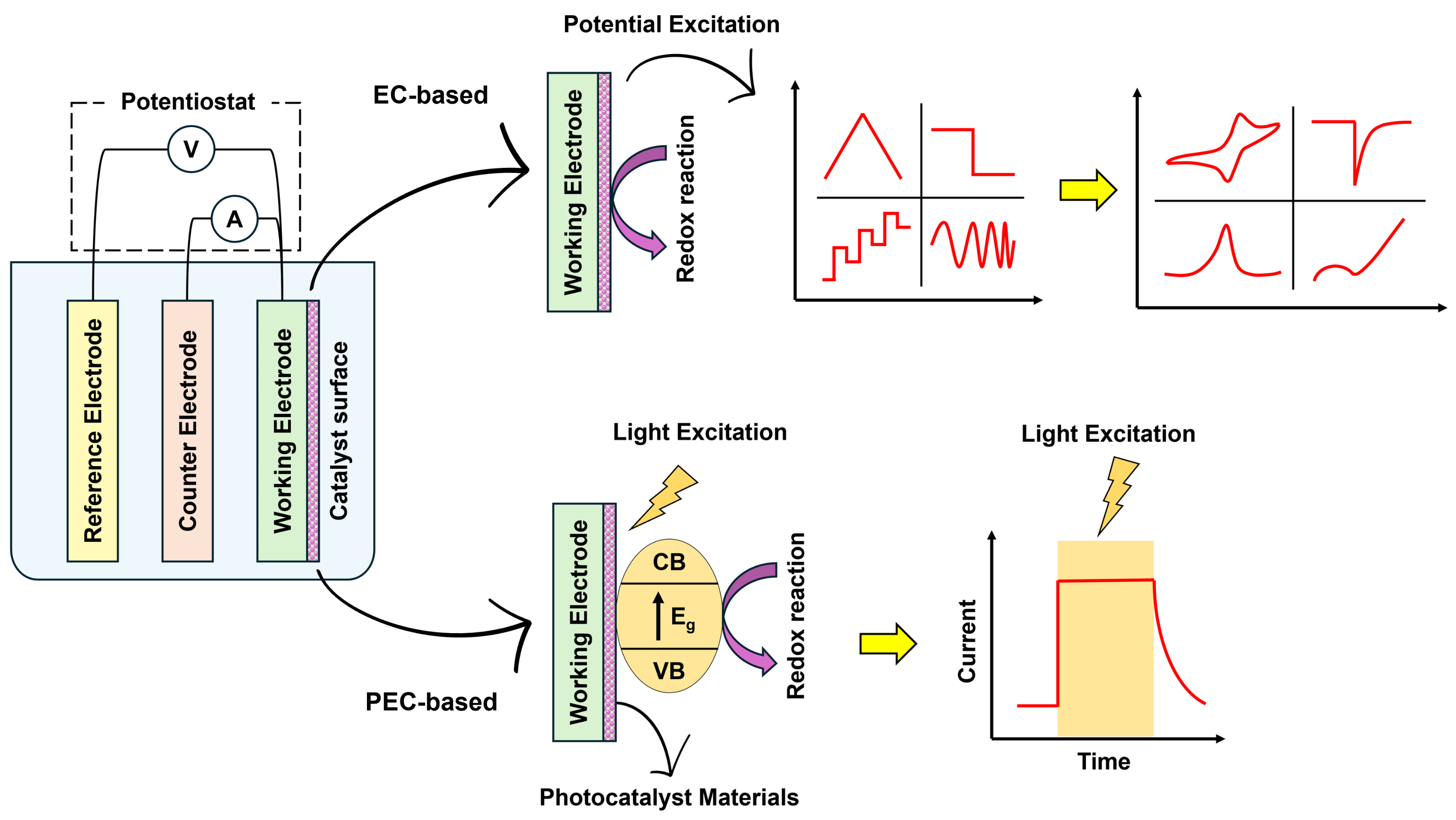
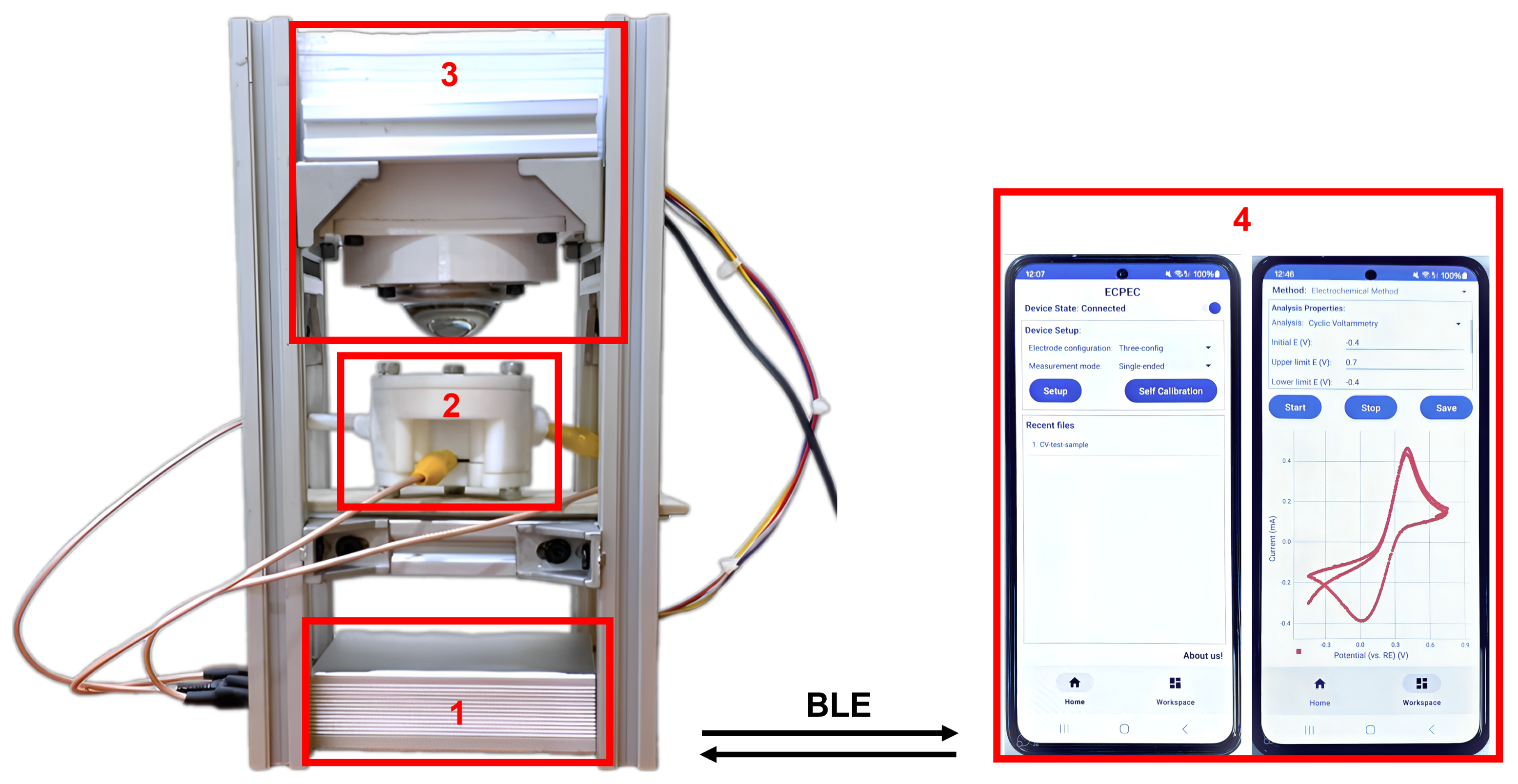
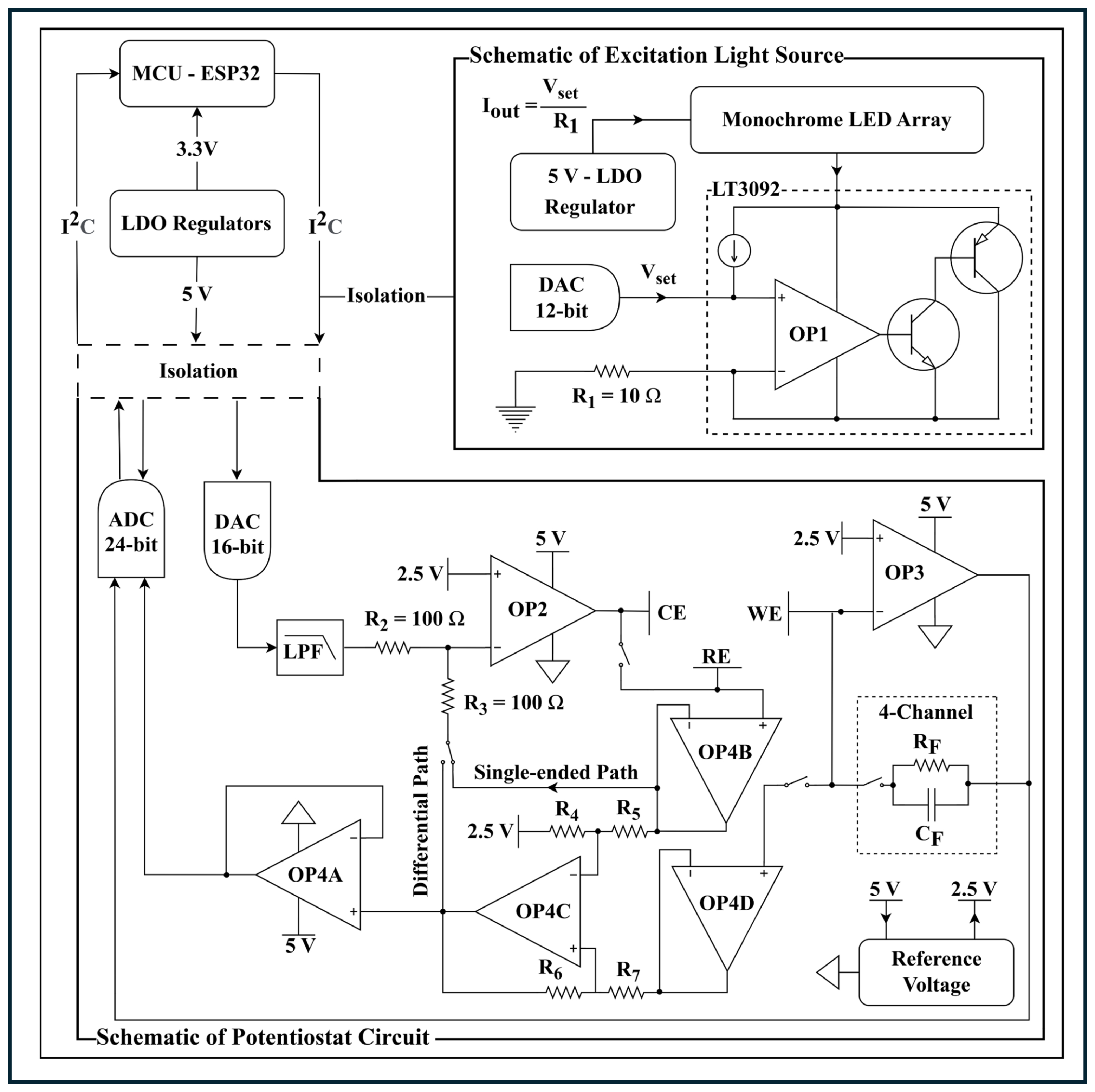



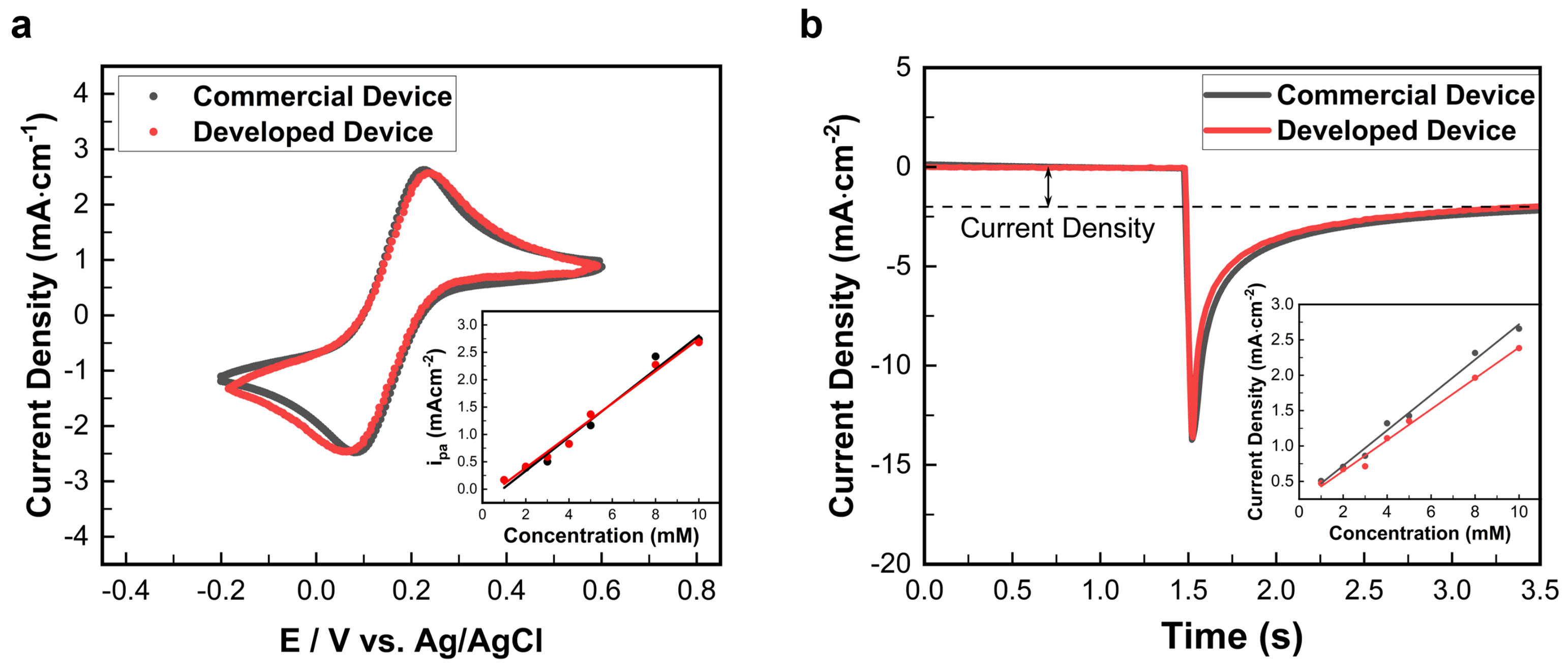

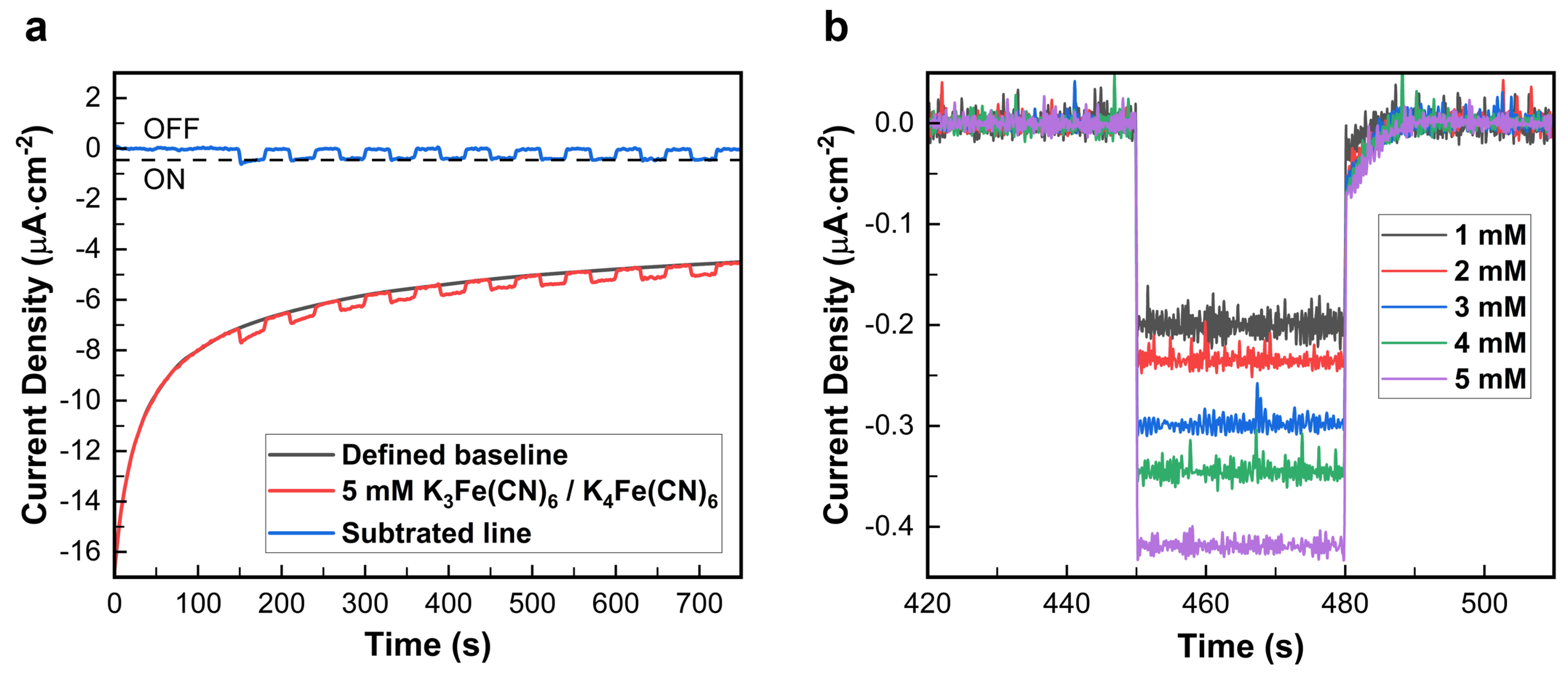
| Designed System | Measurements | Number of Integrated Lights | Current Range | Supported EIS | Software Interface | Wireless Communication |
|---|---|---|---|---|---|---|
| P-EcStat (this work) | EC-PEC | 7 | 1 nA–18 mA | ✠ | Android-based | BLE |
| Shi et al. (2023) [55] | PEC | 3 | ✠ | ✠ | Smartphone-based | Bluetooth |
| Li et al. (2022) [59] | EC-PEC | 1 | ✠ | ✠ | Smartphone-based | Bluetooth |
| Scott et al. (2022) [54] | PEC | 4 | ±10 µA | ✠ | Android-based | BLE |
| Anshori et al. (2022) [60] | EC | ✠ | ±300 µA | ✠ | Android-based | Bluetooth |
| Bott-Neto et al. (2021) [53] | PEC | 1 | ✠ | ✠ | ✠ | ✠ |
| Cordova-Huaman et al. (2021) [61] | EC | ✠ | ±225 µA | ✠ | Android-based | Bluetooth |
| MYSTAT (2021) [50] | EC | ✠ | ±200 mA | ✠ | Windows/OSX/Linux | ✠ |
| Matsubara Y. (2021) [57] | EC | ✠ | 100 mA | ✓ | Labview-based | ✠ |
| Bianchi et al. (2019) [62] | EC | ✠ | ✠ | ✓ | ✠ | Wifi cloud-based |
| MiniStat (2019) [63] | EC | ✠ | ±225 µA | ✠ | ✠ | ✠ |
| KAUSTat (2019) [64] | EC | ✠ | ±500 µA | ✠ | Smartphone-based | BLE |
| ABE-Stat (2019) [52] | EC | ✠ | ✠ | ✓ | Android-based | Wifi |
Disclaimer/Publisher’s Note: The statements, opinions and data contained in all publications are solely those of the individual author(s) and contributor(s) and not of MDPI and/or the editor(s). MDPI and/or the editor(s) disclaim responsibility for any injury to people or property resulting from any ideas, methods, instructions or products referred to in the content. |
© 2024 by the authors. Licensee MDPI, Basel, Switzerland. This article is an open access article distributed under the terms and conditions of the Creative Commons Attribution (CC BY) license (https://creativecommons.org/licenses/by/4.0/).
Share and Cite
Huynh Vo, A.H.; Tran, V.C.; Tran, T.T.; Nguyen, T.T.; Nguyen, A.D.; Huynh Tran, M.H.; Tran, T.N. P-EcStat: A Versatile Design of Photoelectrochemical and Electrochemical Sensing System with Smartphone Interface via Bluetooth Low Energy. Appl. Sci. 2024, 14, 5420. https://doi.org/10.3390/app14135420
Huynh Vo AH, Tran VC, Tran TT, Nguyen TT, Nguyen AD, Huynh Tran MH, Tran TN. P-EcStat: A Versatile Design of Photoelectrochemical and Electrochemical Sensing System with Smartphone Interface via Bluetooth Low Energy. Applied Sciences. 2024; 14(13):5420. https://doi.org/10.3390/app14135420
Chicago/Turabian StyleHuynh Vo, Anh Hao, Viet Cuong Tran, Trung Tin Tran, Thien Trang Nguyen, Anh Duong Nguyen, My Hoa Huynh Tran, and Trung Nghia Tran. 2024. "P-EcStat: A Versatile Design of Photoelectrochemical and Electrochemical Sensing System with Smartphone Interface via Bluetooth Low Energy" Applied Sciences 14, no. 13: 5420. https://doi.org/10.3390/app14135420







